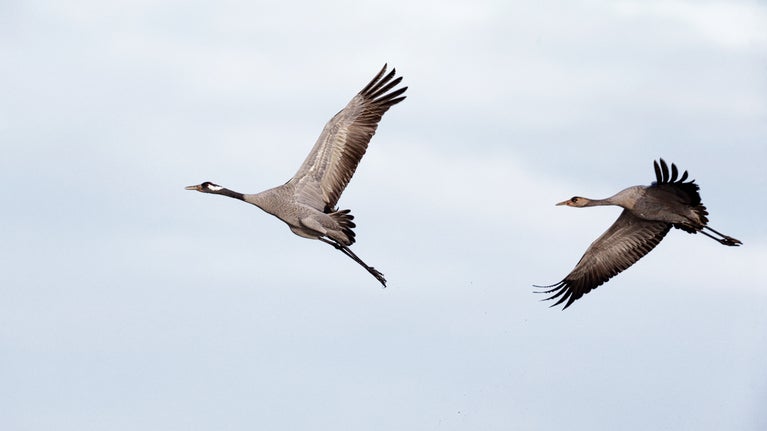Wicken Fen fledges first crane chick
- Published:
- 03 September 2024

Britain's tallest bird is also one of the rarest, a pair of cranes have nested on Wicken Fen since 2019 and this year, have finally reared their first chick.
In its 125th year, the National Trust’s oldest nature reserve has fledged its first crane chick.
Standing at 4ft (1.2 metres) in height, the common crane is Britian’s tallest bird. A pair began breeding on Wicken Fen in 2019, for the first time in a suspected 400 to 500 years.
Notoriously illusive during their breeding season, cranes nest in remote, wet areas, protected from predators and well away from public paths.
The same pair has nested on Wicken Fen in Cambridgeshire for the last six years. Although their eggs have usually hatched, this year is the first time a chick has been successfully reared by the pair.
“Crane chicks are not capable of flight until they reach 10 or 11 weeks old” says Wicken Fen’s Countryside Manager Alan Kell.
“It is when they can fly that we class them as fledged. After half a decade, we now have proof that a crane hatched on Wicken Fen has fledged”.
Crane expert Norman Sills knows many of the fenland breeding crane pairs by sight, due to subtle difference in their appearance, such as how dark or light their bustles are. (‘clump’ of long, drooping wing feathers that fall over crane’s tails when their wings are folded) He spotted the Wicken Fen pair with their flying chick on the Ouse Washes near Welney, where cranes often congregate from August onwards.
Wildlife communicator Ajay Tegala, who works at Wicken Fen and lives near Welney, has been following the progress of the crane family with interest: “For the last few years, the Wicken Fen team have been rooting for the cranes to successfully rear a youngster. When Norman spotted the Wicken Fen pair with a juvenile 12 miles away, we finally knew for sure they’d done it.”
Although getting a photograph of the family was to prove difficult.
“Despite being such tall birds, they can be very hard to spot. Cranes are sensitive to disturbance, so seek out remote, safe places”. Ajay recounts: “After several hours of searching and many miles of walking, I managed to get a blurry photograph on my phone through a telescope, from a safe distance. But it was such an exciting and rewarding moment.”
“It is thanks to the National Trust’s habitat restoration work across the wider Wicken Fen, that cranes returned here and have been able to breed successfully” continues Alan Kell. “And it is a network of similar projects that enables East Anglia to support a growing population of these elegant birds year-round.”
“It is vital that conservation organisations work together to both look after our precious wetlands and create more spaces for rare wildlife” adds Lizzie Bruce, Site Manager at WWT Welney.
“We recently had 22 cranes, including 8 juveniles, making use of our restored wetland on Lady Fen. Seeing cranes at Welney, and the Ouse Washes, which have fledged from Wicken Fen and other sites in the Fens, shows how important it is that a network of suitable habitats is available for them.”
The UK crane population has been steadily increasing, with 23 pairs nesting in The Fens this year. It is another feather in Wicken Fen’s cap to be contributing to this conservation success story.